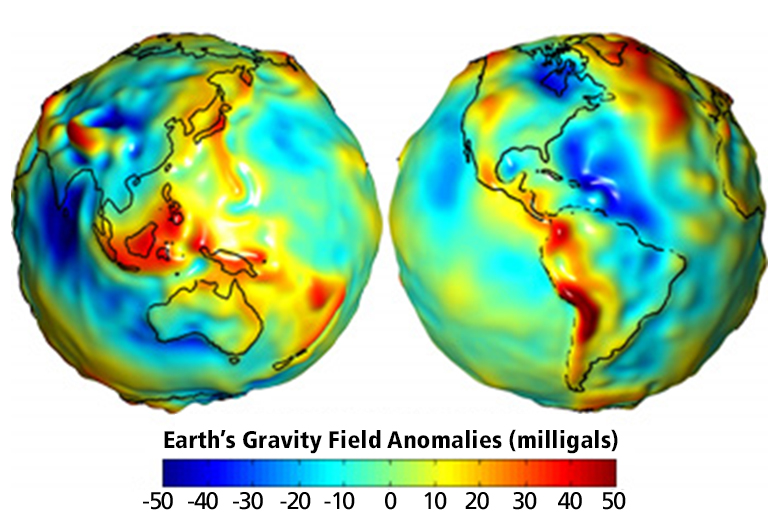
There’s one Earth system that constantly affects our lives, yet we hardly think about it. That is, until we turn 50 and we’re confronted with the evidence. I’m talking, of course, about gravity.
Working against it keeps our muscles toned, and the rest of us…not so toned. But it keeps us standing upright, keeps water in our glasses and in the oceans. In fact, Earth as we know it couldn’t exist without gravity.
All objects exert a gravitational pull on other objects. The strength of this pull is determined by the object’s size and density.
The sun has more gravitational pull than Earth, which holds Earth in orbit around it. The moon has less than Earth—and thus orbits around us—but still has enough gravity to pull on Earth’s water, causing tides.
If Earth had a smooth surface, and were the same density in all places, gravity would be the same everywhere. But it’s neither of these things.
If you’re standing next to a mountain and holding a lead weight on a string, that weight would not hang perfectly straight but would be drawn slightly toward the mountain. Not enough for you to notice, but measurable with a sensitive instrument.
Mountain ranges in general have stronger gravitational pull than, say, oceans, since rock is denser than water. It’s the different densities of different places on Earth that cause Earth’s gravity to vary.
We’ll explore the surprising things that changing gravity reveals on a future EarthDate.
Background
Synopsis: Earth’s gravity is everywhere, and everything with mass exerts gravitational pull on everything else. Materials with different densities on Earth’s surface and in its interior influence Earth’s gravitational pull—mountains actually pull plumb bobs toward them because of their large mass compared to the air around them.
- Gravity is invisible, and it’s everywhere. The force of Earth’s gravity pulls us toward the center of Earth’s mass and keeps us standing upright, no matter where we are on the globe.
- Gravity keeps water in our drinking glasses and food on our plates.
- It causes apples to fall to the ground.
- The moon’s gravity pulls on Earth’s water to cause tides.
- The sun’s gravity keeps Earth in its orbit.
- Every object with mass exerts a gravitational pull on every other mass, and as an object’s mass increases, its gravitational attraction increases.
- Objects that are denser have a greater concentration of mass, thus creating a larger gravitational pull than a same-sized object with lower density—i.e., a cubic foot of solid rock will exert a larger pull on its surroundings than a cubic foot of ocean.
- If you are standing next to a mountain holding a plumb bob, the mountain will exert a gravitational pull on you, so the plumb bob will divert ever so slightly toward it.
- Humans don’t feel the slight differences in gravitational pull, but our sensitive instruments do.
- If Earth were a homogenous, smooth ellipsoid, then the gravitational pull would be the same everywhere and perpendicular to the surface of the ellipsoid.
- The ocean surface would also be a perfect ellipsoid.
- Because Earth is rugged and composed of materials with widely differing densities in three dimensions from its core to its surface, gravitational pull varies.
- Scientists have defined a bumpy surface called a geoid to describe the long-term average or “mean” configuration of Earth’s gravitational pull.
- Everywhere on Earth, water aligns parallel to the geoid, and plumb bobs hang perpendicular to it, pulled by the force of gravity in that specific location.
- Earth’s gravitational field is constantly shifting because its dynamic surface processes cause local changes in mass that occur on shorter time scales; these changes in the local gravity field can be tracked as the “time-variable” gravity field over periods of years, including the following:
- Redistribution of mass from tectonic events like volcanic eruptions and earthquakes.
- Changing mass of polar ice sheets and distribution of ocean currents.
- Shifting masses of groundwater and even soil moisture.
- NASA satellites can track gravity changes. Listen to next week’s story for how that happens and what they measure.

